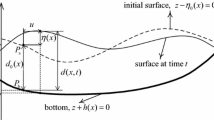Abstract
Numerical solution of shallow-water equations (SWE) has been a challenging task because of its nonlinear hyperbolic nature, admitting discontinuous solution, and the need to satisfy the (C)-property. The presence of source terms in momentum equations, such as the bottom slope and friction of bed, compounds the difficulties further. In this paper, a least-squares finite-element method for the space discretization and (θ)-method for the time integration is developed for the 2D non-conservative SWE including the source terms. Advantages of the method include: the source terms can be approximated easily with interpolation functions, no upwind scheme is needed, as well as the resulting system equations is symmetric and positive-definite, therefore, can be solved efficiently with the conjugate gradient method. The method is applied to steady and unsteady flows, subcritical and transcritical flow over a bump, 1D and 2D circular dam-break, wave past a circular cylinder, as well as wave past a hump. Computed results show good (C)-property, conservation property and compare well with exact solutions and other numerical results for flows with weak and mild gradient changes, but lead to inaccurate predictions for flows with strong gradient changes and discontinuities.
Similar content being viewed by others
References
Abbot M.B., Damsgaard A., Rodenhuis G.S.: SYSTEM 21, “Jupiter”, a design system for two-dimensional nearly horizontal flows. J. Hydraul. Res. 11, 1–28 (1973)
Johnson R.S.: A Modern Introduction to the Mathematical Theory of Water Waves. Cambridge University Press, Cambridge (1997)
Li Y.S., Zhan J.M.: Boussinesq-type model with boundary-fitted coordinate system. J. Waterw. Port Coast. Ocean Eng. 127, 152–160 (2001)
Madsen P.A., Sorensen O.R., Schaffer H.A.: Surf zone dynamics simulated by a Boussinesq type model. Part I. Model description and cross-shore motion of regular waves. Coast. Eng. 32, 255–287 (1997)
Nwogu O.: An alternative form of the Boussinesq equations for modeling the propagation of waves from deep to shallow water. J. Waterw. Port Coast. Ocean Eng. 119(6), 618–638 (1993)
Peregrine D.H.: Long waves on a beach. J. Fluid Mech. 27(4), 815–827 (1967)
Ambrosi D.: Approximation of shallow water equations by Roe’s Reimann solver. Int. J. Numer. Methods Fluids 20, 157–168 (1995)
Xing Y., Shu C.W.: High order finite difference WENO schemes for a class of hyperbolic systems with source terms. J. Comput. Phys. 208, 206–227 (2005)
Xing Y., Shu C.W.: High order well-balanced finite volume WENO schemes and Discontinuous Galerkin methods for a class of hyperbolic systems with source terms. J. Comput. Phys. 214, 567–598 (2006)
LeVeque R.J.: Numerical Methods for Conservation Laws. Birkhauser-Verlag, Berlin (1990)
Toro E.F.: Reimann Solvers and Numerical Methods for Fluid Dynamics. Springer, Berlin (1997)
Burguette J., Garcia-Navarro P.: Efficient construction of high-resolution TVD conservative schemes for equations with source terms: application to shallow water flows. Int. J. Numer. Methods Fluids 37, 209–248 (2001)
LeVeque R.J.: Balancing source terms and flux gradients in high-resolution Godunov methods: the quasi-steady wave-propagation algorithm. J. Comput. Phys. 146, 346–365 (1998)
Zhou J.G., Causon D.M., Mingham C.G., Ingram D.M.: The surface gradient method for the treatment of source terms in the shallow-water equations. J. Comput. Phys. 168, 1–25 (2001)
Rebollo T.C., Delgado A.D., Nieto E.D.F.: A family of stable numerical solvers for the shallow water equations with source terms. Comput. Methods Appl. Mech. Eng. 192, 203–225 (2003)
Alessandro V., Caleffi V., Zanni A.: Case study: Malpasset dam-break simulation using a two-dimensional finite volume method. J. Hydraul. Eng. 128(5), 460–472 (2002)
Cheng, R.T.: Modeling of hydraulic systems by finite element methods. Adv. Hydrosci. 11, 207–284 (1978)
Gracia R., Kahawita R.A.: Numerical solution of the St. Venant equations with the MacCormack finite element scheme. Int. J. Numer. Methods Fluids 6, 507–527 (1986)
Hervouet J.M.: Hydrodynamics of Free Surface Flows: Modelling with the Finite Element Method. Wiley, New York (2007)
Alcrudo F., Garcia-Navarro P.: A high resolution Godunov-type scheme in finite volume for the 2D shallow water equation. Int. J. Numer. Methods Fluids 16, 489–505 (1993)
Fujihara M., Borthwick A.G.L.: Godunov-type solution of curvilinear shallow-water equations. J. Hydraul. Eng. 126, 827–836 (2000)
Zhou J.G.: A lattice Boltzmann model for the shallow water equations. Comput. Methods Appl. Mech. Eng. 191, 3527–3539 (2002)
Bochev P.B., Gunzburger M.D.: Finite element methods of least-squares type. SIAM Rev. 40(4), 789–837 (1998)
Deang J.M., Gunzburger M.D.: Issues related to least-squares finite element methods for the stokes equations. SIAM J. Sci. Comput. 20(3), 878–906 (1998)
Gunzburger M.D.: Finite Element Methods for Viscous Incompressible Flows. Academic Press, Boston (1989)
Jiang B.N.: The Least-Squares Finite Element Method. Springer, Berlin (1998)
Laibel J.P., Pinder G.F.: Solution of the shallow water equations by least squares collocation. Water Resour. Res. 29, 445–455 (1993)
Girault V., Raviart P.: Finite Element Methods for Navier-Stokes Equations: Theory and Algorithm. Springer, Berlin (1986)
Carey G.F., Jiang B.N.: Element-by-element linear and nonlinear solution scheme. Commun. Appl. Numer. Methods 2, 145–153 (1986)
Reddy J.N.: Energy Principles and Variational Methods in Applied Mechanics, 2nd edn. Wiley, New York (2002)
Toro E.F.: Shock-Capturing Methods for Free-Surface Shallow Flows. Wiley, New York (2001)
Hou T.Y., LeFeloch P.: Why non-conservative schemes converges to the wrong solutions: error analysis. Math. Comput. 62, 497–530 (1994)
Bermudez A., Vazquez M.E.: Upwind methods for hyperbolic conservation laws with source terms. Comput. Fluids 23, 1049–1071 (1994)
Akoh R., Ii S., Xiao F.: A CIP/multi-moment finite volume method for shallow water equations with source terms. Int. J. Numer. Methods Fluids 56, 2245–2270 (2008)
Author information
Authors and Affiliations
Corresponding author
Rights and permissions
About this article
Cite this article
Liang, SJ., Hsu, TW. Least-squares finite-element method for shallow-water equations with source terms. Acta Mech Sin 25, 597–610 (2009). https://doi.org/10.1007/s10409-009-0250-x
Received:
Revised:
Accepted:
Published:
Issue Date:
DOI: https://doi.org/10.1007/s10409-009-0250-x




